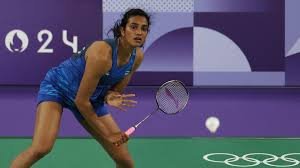After P.V. Sindhu, Who Will Be the Next Star in Indian Women’s Badminton?
With a shrinking talent pool, dependence on Pullela Gopichand, and lack of quality coaching, the future of Indian women’s badminton seems uncertain…
 New Delhi,: Over the past two decades, Indian badminton has witnessed a revolution, thanks largely to the rise of stars like Saina Nehwal, Jwala Gutta, Ashwini Ponappa, and P.V. Sindhu. These athletes have not only brought glory to the country but have also inspired a generation of young girls to dream big in the sport. However, as P.V. Sindhu, one of India’s most successful athletes, continues her career into its next phase, a question looms: Who will emerge as the next big star in Indian women’s badminton?
New Delhi,: Over the past two decades, Indian badminton has witnessed a revolution, thanks largely to the rise of stars like Saina Nehwal, Jwala Gutta, Ashwini Ponappa, and P.V. Sindhu. These athletes have not only brought glory to the country but have also inspired a generation of young girls to dream big in the sport. However, as P.V. Sindhu, one of India’s most successful athletes, continues her career into its next phase, a question looms: Who will emerge as the next big star in Indian women’s badminton?
The answer to this question is far from clear. While Indian badminton has enjoyed significant success on the global stage, it is now facing multiple challenges that threaten to impede its future growth. At the heart of this dilemma is the shrinking talent pool, a reliance on Pullela Gopichand’s academy, and a lack of quality coaches to develop young players.
The Gachibowli area of Hyderabad, home to the Pullela Gopichand Badminton Academy, has long been a hub for aspiring badminton players. Thousands of parents, eager for their daughters to follow in the footsteps of former champions, make their way to the academy every year. The academy, a state-of-the-art facility built by the Dronacharya awardee, has been a breeding ground for India’s best-known badminton stars. It is here that Sindhu, Nehwal, and others honed their skills, eventually making their mark on the world stage.
Yet, despite the academy’s success, the pipeline of talent has slowed down in recent years. The rise of badminton as a popular sport in India has led to greater competition, but the number of women breaking through at the international level remains limited. While P.V. Sindhu continues to be a dominant force on the global circuit, her age and the physical demands of elite badminton raise concerns about the sustainability of her reign at the top.
A Shrinking Talent Pool and Overreliance on Gopichand Academy
One of the critical issues facing Indian women’s badminton today is the decreasing number of young players emerging at the international level. Despite the growing interest in the sport, the numbers are not translating into consistent results. A few promising names have emerged, but there has been a lack of continuity at the top. Players who enter the Gopichand Academy are often forced to compete with a limited number of spots in the national rankings, and the pressure to perform can sometimes overwhelm them.
Moreover, there is an over-reliance on Pullela Gopichand’s academy to produce top talent. While Gopichand has been instrumental in the development of the sport in India, his singular focus on his academy has meant that other regions and academies have struggled to make an impact. For a sport to thrive, it requires multiple avenues for talent identification and coaching, yet there is a shortage of quality coaches outside the Gopichand system. This has left many potential athletes with fewer options to pursue their careers, especially in the rural areas, where badminton has yet to gain the same prominence as cricket.
The Coaching Crisis
While India has produced world-class players, the lack of a robust coaching ecosystem has hindered the development of the sport at grassroots levels. The shortage of trained and experienced coaches is one of the biggest bottlenecks facing Indian badminton. There is a significant gap between the training offered in the best academies and what is available in smaller towns or district-level programs. This has resulted in a situation where only the privileged few who can afford to travel to Gachibowli or other major cities have access to top-tier coaching.
Looking Ahead: Who Will Step Up?
With Sindhu’s career gradually entering a different phase, there is a growing need for the next generation of women badminton stars to emerge. A few promising names, like Malvika Bansod and Aakarshi Kashyap, have already made waves at national and international tournaments. However, none have shown the same consistency or breakthrough potential as Sindhu or Nehwal did at the same stage of their careers.
The real question is whether India can continue to build upon its success in women’s badminton, or whether it will be left in a state of stagnation. The sport’s future hinges on the ability of the next generation of players to step up, the creation of a more sustainable and diversified coaching ecosystem, and the ability to adapt to the rapidly changing landscape of international badminton.
While the road ahead may be uncertain, one thing is clear: Indian badminton’s future relies on harnessing and nurturing the next generation of female athletes who can carry the torch forward. As we continue to wait for the next star to emerge, the legacy of P.V. Sindhu serves as both an inspiration and a benchmark for future success in the sport.

Comments are closed.